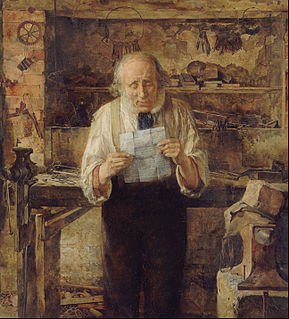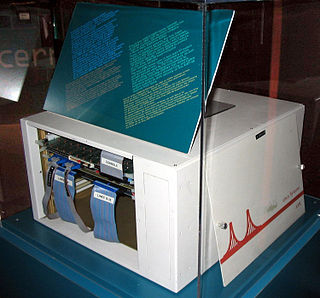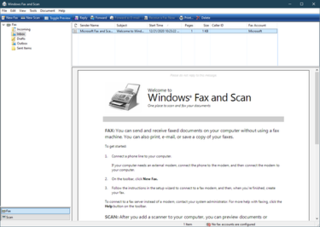External links
| | This Internet-related article is a stub. You can help Wikipedia by expanding it. |
T.37 is an ITU standard which deals with sending fax messages using email. It is also referred to as "Internet fax" or "Store-forward-fax".
A fax machine supporting T.37 will send a fax to an email address by converting the document to a TIFF-F image, attaching it to an email (using the MIME format), and sending the document (using SMTP). The destination fax receives the email and prints the attached document.
To interface with regular fax machines:
| | This Internet-related article is a stub. You can help Wikipedia by expanding it. |

Electronic mail is a method of exchanging messages ("mail") between people using electronic devices. Email entered limited use in the 1960s, but users could only send to users of the same computer, and some early email systems required the author and the recipient to both be online simultaneously, similar to instant messaging. Ray Tomlinson is credited as the inventor of email; in 1971, he developed the first system able to send mail between users on different hosts across the ARPANET, using the @ sign to link the user name with a destination server. By the mid-1970s, this was the form recognized as email.

Fax, sometimes called telecopying or telefax, is the telephonic transmission of scanned printed material, normally to a telephone number connected to a printer or other output device. The original document is scanned with a fax machine, which processes the contents as a single fixed graphic image, converting it into a bitmap, and then transmitting it through the telephone system in the form of audio-frequency tones. The receiving fax machine interprets the tones and reconstructs the image, printing a paper copy. Early systems used direct conversions of image darkness to audio tone in a continuous or analog manner. Since the 1980s, most machines modulate the transmitted audio frequencies using a digital representation of the page which is compressed to quickly transmit areas which are all-white or all-black.

A letter is a written message conveyed from one person to another through a medium. The term usually excludes written material intended to be read in its original form by large numbers of people, such as newspapers and placards; however even these may include material in the form of an "open letter". Letters can be formal or informal. Besides being a means of communication and a store of information, letter writing has played a role in the reproduction of writing as an art throughout history. Letters have been sent since antiquity and are mentioned in the Iliad. Historians Herodotus and Thucydides mention and use letters in their writings.

A router is a networking device that forwards data packets between computer networks. Routers perform the traffic directing functions on the Internet. Data sent through the internet, such as a web page or email, is in the form of data packets. A packet is typically forwarded from one router to another router through the networks that constitute an internetwork until it reaches its destination node.

SMS is a text messaging service component of most telephone, Internet, and mobile device systems. It uses standardized communication protocols that let mobile devices exchange short text messages. An intermediary service can facilitate a text-to-voice conversion to be sent to landlines.

An email client, email reader or more formally mail user agent (MUA) is a computer program used to access and manage a user's email.
Telephone number mapping is a system of unifying the international telephone number system of the public switched telephone network with the Internet addressing and identification name spaces. Internationally, telephone numbers are systematically organized by the E.164 standard, while the Internet uses the Domain Name System (DNS) for linking domain names to IP addresses and other resource information. Telephone number mapping systems provide facilities to determine applicable Internet communications servers responsible for servicing a given telephone number using DNS queries.
S/MIME is a standard for public key encryption and signing of MIME data. S/MIME is on an IETF standards track and defined in a number of documents, most importantly RFC 3369, 3370, 3850 and 3851. It was originally developed by RSA Data Security and the original specification used the IETF MIME specification with the de facto industry standard PKCS#7 secure message format. Change control to S/MIME has since been vested in the IETF and the specification is now layered on Cryptographic Message Syntax (CMS), an IETF specification that is identical in most respects with PKCS #7. S/MIME functionality is built into the majority of modern email software and interoperates between them. Since it is built on CMS, MIME can also hold an advanced electronic signature.
Store and forward is a telecommunications technique in which information is sent to an intermediate station where it is kept and sent at a later time to the final destination or to another intermediate station. The intermediate station, or node in a networking context, verifies the integrity of the message before forwarding it. In general, this technique is used in networks with intermittent connectivity, especially in the wilderness or environments requiring high mobility. It may also be preferable in situations when there are long delays in transmission and variable and high error rates, or if a direct, end-to-end connection is not available.
Apple Open Collaboration Environment (AOCE), is a collection of messaging-related technologies introduced for the classic Mac OS in the early 1990s. It includes the PowerTalk mail engine, which is the primary client-side interface to the system, the PowerShare mail server for workgroup installations, and a number of additional technologies such as Open Directory, encryption, and digital signature support.
JBIG is an early lossless image compression standard from the Joint Bi-level Image Experts Group, standardized as ISO/IEC standard 11544 and as ITU-T recommendation T.82 in March 1993. It is widely implemented in fax machines. Now that the newer bi-level image compression standard JBIG2 has been released, JBIG is also known as JBIG1. JBIG was designed for compression of binary images, particularly for faxes, but can also be used on other images. In most situations JBIG offers between a 20% and 50% increase in compression efficiency over the Fax Group 4 standard, and in some situations, it offers a 30-fold improvement.
A fax server is a system installed in a local area network (LAN) server that allows computer users whose computers are attached to the LAN to send and receive fax messages.
Internet fax, e-fax, or online fax is the use of the internet and internet protocols to send a fax (facsimile), rather than using a standard telephone connection and a fax machine. A distinguishing feature of Internet fax, compared to other Internet communications such as email, is the ability to exchange fax messages with traditional telephone-based fax machines.
Windows Messaging, initially called Microsoft Exchange Client, is an email client that was included with Windows 95, 98 and Windows NT 4.0.
T.38 is an ITU recommendation for allowing transmission of fax over IP networks (FoIP) in real time.

Windows Fax and Scan is an integrated faxing and scanning application included in some versions of the Windows Vista operating system and all versions of Windows 7, Windows 8 and Windows 10. Windows XP includes Fax Console instead. The software is not compatible with T.38 technology and cannot be used for internet faxes.

A fax modem enables a computer to transmit and receive documents as faxes on a telephone line. A fax modem is like a data modem but is designed to transmit and receive documents to and from a fax machine or another fax modem. Some, but not all, fax modems do double duty as data modems. As with other modems, fax modems can be internal or external. Internal fax modems are often called fax boards.
Zapmail was a service, launched in 1984 by Federal Express (FedEx) whereby fax transmission was offered to customers as a means to expedite delivery of documents. This was before the widespread availability and use of fax services in homes and businesses. Eventually judged a commercial failure, it was discontinued just over two years later.
Voice Profile for Internet Mail (VPIMv2) is defined in RFC 3801, an Internet standards track protocol.
MCI Mail was one of the first ever commercial email services in the United States and one of the largest telecommunication services in the world. Operated by MCI Communications Corp. from 1983 to 2003, MCI Mail offered its customers a low cost and effective solution for sending and receiving electronic mail.